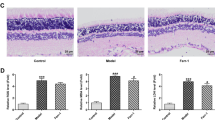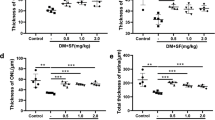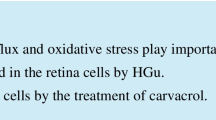Abstract
Background
Diabetic retinopathy (DR) is a leading cause of acquired blindness in adults. Previous research has shown that the apoptosis of retinal ganglion cells(RGCs) plays an important role in the initiation and development of diabetic retinopathy. The positive effect of estrogen on the nervous system is currently attracting increasing attention. In this study, we investigated whether17β-estradiolum (E2) has protective effects on RGCs in a high-glucose environment.
Methods
The cell survival rates were measured by Cell Counting Kit-8, the apoptosis was detected by flow cytometry, the intracellular reactive oxygen species (ROS) levels were examined by immunofluorescence method, and the intracellular mitochondrial membrane potential was examined by confocal microscopy. The expression levels of cytochrome C, Bcl-2, and Bax were analyzed by Western blot method. The effect of estrogen receptor blocker tamoxifen on the RGCs was also evaluated.
Results
It was found that E2 stabilizes the mitochondrial membrane potential, reduces intracellular ROS levels, up-regulates Bcl-2 expression, inhibits Bax expression, decreases the generation of cytochrome C, and finally reduces the apoptosis of RGC-5 cells in a high-glucose environment. These protective functions could be attributed to E2 receptors, which make E2 a prospective patent application candidate in the treatment of DR. Furthermore, when cells were pre-cultured with tamoxifen, we found that tamoxifen inhibited the shielding effects of E2.
Conclusion
E2 has a broad application prospect in the treatment of DR.







Similar content being viewed by others
References
Bearse MA Jr, Han Y, Schneck ME, Barez S, Jacobsen C, Adams AJ (2004) Local multifocal oscillatory potential abnormalities in diabetes and early diabetic retinopathy. Invest Ophthalmol Vis Sci 45:3259–3265
Ghirlanda G, Di Leo MA, Caputo S, Cercone S, Greco AV (1997) From functional to microvascular abnormalities in early diabetic retinopathy. Diabetes Metab Rev 13:15–35
Correia SC, Santos RX, Cardoso S, Carvalho C, Santos MS, Oliveira CR, Moreira PI (2010) Effects of estrogen in the brain: is it aneuroprotective agent in Alzheimer’s disease? Curr Aging Sci 3:113–126
Zhou X, Li F, Ge J, Sarkisian SR, Tomita H, Zaharia A, Chodosh J, Cao W (2007) Retinal ganglion cell protection by 17-β Estradiol in a mouse model of inherited glaucoma. Dev Neurobiol 67:603–616
Kobayashi K, Kobayashi H, Ueda M, Honda Y (1998) Estrogen receptor expression in bovine and rat retinas. Invest Ophthalmol Vis Sci 39:2105–2110
Chatziralli IP, Sergentanis TN, Keryttopoulos P, Vatkalis N, Agorastos A, Papazisis L (2010) Risk factors associated with diabetic retinopathy in patients with diabetes mellitus type 2. BMC Res Notes 3:153
Zhang X, Saaddine JB, Chou CF, Cotch MF, Cheng YJ, Geiss LS, Gregg EW, Albright AL, Klein BEK, Klein R (2010) Prevalence of diabetic retinopathy in the United States, 2005–2008. JAMA 304:649–656
Niizuma K, Endo H, Chanm PH (2009) Oxidative stress and mitochondrial dysfunction as determinants of ischemic neuronal death and survival. J Neurochem 109:133–138
Sancho P, Fernandez C, Yuste VJ, Amran D, Ramos AM, de Blas E, Susin SA, Aller P (2006) Regulation of apoptosis/necrosis execution in cadmium-treated human promonocytic cells under different forms of oxidative stress. Apoptosis 11:673–686
Anuradha CD, Kanno S, Hirano S (2001) Oxidative damage to mitochondria is a preliminary step to caspase-3 activation in fluoride-induced apoptosis in HL-60 cells. Free Radic Biol Med 31:367–373
Phaneuf S, Leeuwenburgh C (2002) Cytochromec release from mitochondria in the aging heart: a possible mechanism for apoptosis with age. Am J Physiol Regul Integr Comp Physiol 282:423–430
Arnold S, Beyer C (2009) Neuroprotection by estrogen in the brain: the mitochondrial compartment as presumed therapeutic target. J Neurochem 110:1–11
Kowluru RA, Tang J, Kern TS (2001) Abnormalities of retinal metabolism in diabetes and experimental galactosemia VII. Effect of long-term administration of anti-oxidants on the development of retinopathy. Diabetes 50:1938–1942
Vidya D, Shekhar R, Prabodh S, Chowdary NVS, Reddy MCDMJ (2011) Oxidative stress in diabetic retinopathy. JCDR 5:994–997
Fu Z, Kuang HY, Hao M, Gao XY, Liu Y, Shao N (2012) Protection of exenatide for retinal ganglion cells with different glucose concentrations. Peptides 37:25–31
Wassmann S, Bäumer AT, Strehlow K, Eickels MV, Grohé C, Ahlbory K, Rösen R, Böhm M, Nickenig G (2001) Endothelial dysfunction and oxidative stress during estrogen deficiency in spontaneously hypertensive rats. Circulation 103:435–441
Norikatsu K, Naoto A, Keyue L, Tatsuru A (2005) Acute effects of 17[beta]-estradiol on oxidative stress in ischemic rat striatum. J Neurosurg Anesthesiol 17:27–32
Mariana AP, Hao J, Alba IR, Cristina L, Robert AL, Selva RA (2006) Estrogen counteracts ozone-induced oxidative stress and nigral neuronal death. Neuroreport 17:629–633
Wallace DR, Dodson S, Nath A, Booze RM (2006) Estrogen attenuates gp120-and tat1-72-induced oxidative stress and prevents loss of dopamine transporter function. Synapse 59:51–60
Chen JQ, Delannoy M, Cooke C, Yager JD (2004) Mitochondrial localization of ERalpha and ERbeta in human MCF7 cells. Am J Physiol Endocrinol Metab 286:1011–1022
Chen JQ, Eshete M, Alworth WL, Yager JD (2004) Binding of MCF-7 cell mitochondrial proteins and recombinant human estrogen receptors alpha and beta to human mitochondrial DNA estrogen response elements. J Cell Biochem 93:358–373
Yang SH, Liu R, Perez EJ, Wen Y, Stevens SM, Valencia T, Brun-Zinkernagel AM, Prokai L, Will Y, Dykens J, Koulen P, Simpkins JW (2004) Mitochondrial localization of estrogen receptor β. Proc Natl Acad Sci 101:4130–4135
Razmara A, Duckles SP, Krause DN, Procaccio V (2007) Estrogen suppresses brain mitochondrial oxidative stress in female and male rats. Brain Res 1176:71–81
Ogueta SB, Schwartz SD, Yamashita CK, Farber DB (1999) Estrogen receptor in the human eye: influence of gender and age on gene expression. Invest Ophthalmol Vis Sci 40:1906–1911
Kim H, Bang OY, Jung MW, Ha SD, Hong HS, Huh K, Kim SU, Mook-Jung I (2001) Neuroprotective effects of estrogen against beta-amyloid toxicity are mediated by estrogen receptors in culturedneuronal cells. Neurosci Lett 302(1):58–62
Borrás C, Gambini J, López-Grueso R, Pallardó FV, Viña J (2010) Direct antioxidant and protective effect of estradiol on isolated mitochondria. Biochim Biophys Acta 1802:205–211
Ow PYL, Green DR, Hao Z, Mak TW (2008) Cytochrome c: functions beyond respiration. Nat Rev Mol Cell Biol 9:532–542
Chipuk JE, Green DR (2008) How do BCL-2 proteins induce mitochondrial outer membrane permeabilization? Trends Cell Biol 18:157–164
Ding F, Shao ZW, Yang SH, Wu Q, Gao F, Xiong LM (2012) Role of mitochondrial pathway in compression-induced apoptosis of nucleus pulposus cells. Apoptosis 17:579–590
Brunelle JK, Letai A (2009) Control of mitochondrial apoptosis by the Bcl-2 family. J Cell Sci 122:437–441
Kang MH, Reynolds CP (2009) Bcl-2 inhibitors: targeting mitochondrial apoptotic pathways in cancer therapy. Clin Cancer Res 15:1126–1132
Martinou JC, Youle RJ (2011) Mitochondria in apoptosis: Bcl-2 family members and mitochondrial dynamics. Dev Cell 21:92–101
Broughton BRS, Reutens DC, Sobey CG (2009) Apoptotic mechanisms after cerebral ischemia. Stroke 40:331–339
Wang C, Jie C, Dai X (2014) Possible roles of astrocytes in estrogen neuroprotection during cerebral ischemia. Neuroscience 25(2):255–268
Acknowledgments
We thank the Key Laboratory of Hepatosplenic Surgery (Harbin Medical University) Ministry of Education. This work was supported by The National Science Foundation for Post-doctoral Scientists of China (Grant No: 20090451019).
Conflict of interest
The authors report no conflicts of interest. The authors alone are responsible for the content and writing of the paper
Author information
Authors and Affiliations
Corresponding author
Additional information
Ming Hao and Yue Li contributed equally to this work
Rights and permissions
About this article
Cite this article
Hao, M., Li, Y., Lin, W. et al. Estrogen prevents high-glucose-induced damage of retinal ganglion cells via mitochondrial pathway. Graefes Arch Clin Exp Ophthalmol 253, 83–90 (2015). https://doi.org/10.1007/s00417-014-2771-7
Received:
Revised:
Accepted:
Published:
Issue Date:
DOI: https://doi.org/10.1007/s00417-014-2771-7




